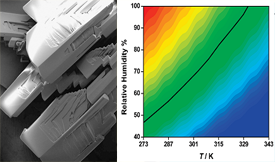
Structure and Energetics of a New Hydrate of 4'-Hydroxyacetophenone
Cryst. Growth Des. 2010, 10, 3070-3076. DOI: 10.1021/cg1001804
Abstract
The standard (pº = 0.1 MPa) molar enthalpies of formation of 2-biphenylmethanol (2BPM) and 4-biphenylmethanol (4BPM) in the crystalline state, at T = 298.15 K, were determined by static-bomb combustion calorimetry as ∆fHom (2BPM, cr) = -(107.9 ± 3.7) kJ/mol and ∆fHom (4BPM, cr) = -(121.5 ± 4.2) kJ/mol, respectively. The corresponding enthalpies of sublimation, ∆subHom (2BPM, cr) = (107.1 ± 0.6) kJ/mol and ∆subHom (4BPM, cr) = (107.3 ± 1.8) kJ/mol, were obtained by Calvet drop microcalorimetry and Knudsen-effusion vapour-pressure measurements. From the above results it was possible to derive ∆fHom (2BPM, g) = -(0.8 ± 3.7)kJ/mol, ∆fHom (4BPM, g) = (14.2 ± 4.6) kJ/mol. These values, in conjunction with the experimental enthalpies of formation of benzene, biphenyl, and benzyl alcohol taken from the literature, were used to assess the predictions of the MPW1PW91/6-31G(d), B3LYP/6-31G(d), and B3LYP/6-311+G(d,p) methods for the enthalpy of isodesmic and isogyric reactions involving those species. This test supported the reliability of the theoretical methods, and indicated a good thermodynamic consistency between the ∆fHom (g) source values obtained in this work for the two biphenylmethanol isomers and the corresponding data for benzene, biphenyl, and benzyl alcohol selected from the literature. Finally, the similarity between the obtained enthalpies of sublimation of 2BPM and 4BPM indicates that, despite structural differences in the crystalline state, the two compounds have comparable lattice energies at T = 298.15 K.
Return Previous Next